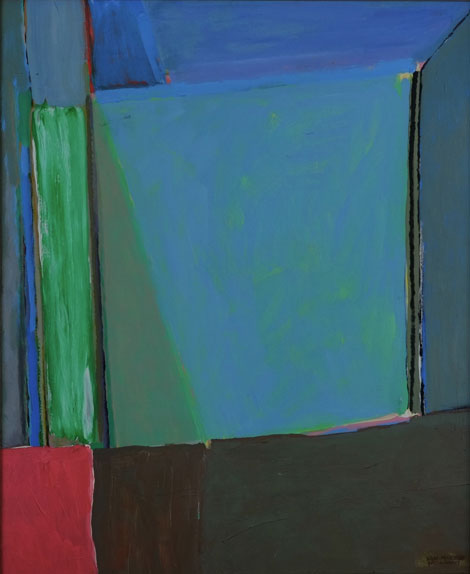Elizabeth McCord’s Big Pink (1951) was the only painting featured in LACMA’s Pacific Standard Time exhibition “Living in a Modern Way,” a sweeping survey of mid-century design. The painting jogged old-timers’ memories and tantalized a younger audience. A recent two-part show at See Line Gallery of works from the late artist’s estate filled out McCord’s artistic history, substantially, respectably, and sometimes impressively.
Nothing in the See Line exhibition(s) rivaled the architectural profundity or even physical breadth of Big Pink; the panels and canvases displayed are mostly easel-size or smaller and veer away from the hard-edged prescience of the 4-foot-long work. Still, her later, more intimate paintings manifest McCord’s eye no less assertively.
McCord (1914–2008), who had studied in Depression-era Chicago, developed her abstract style there and brought it with her to Los Angeles at the end of the war. Despite her involvement with design innovation in Los Angeles, with its reliance on sharp edges and bright colors, she got more and more painterly as she went along. Save for a painting here and there (notably the architectonic “Lintel” series from the later ’70s), the exhibited works are composed of relatively eccentric elements—skewed, irregularly contoured rectangles of various sizes and colors piled together like bricks, as in various acrylics from the ’70s, or set afloat in less colorful, less distinctly articulated fields of such forms, as in many of the ’80s canvases. McCord’s works from the early-to-mid ’60s, in fact, are downright abstract-expressionistic.
Throughout the decades of work presented at See Line, McCord seems to have been responding less to architectural models and more to the image of the landscape. Even when her forms lock themselves most securely into place on the picture plane (as in those “Lintel”-series paintings), they convey more a sense of portal—of frame-within-a-frame views of indistinct but strongly implied natural space—than they do of architecture per se. The palette McCord maintained throughout her career, brimming with dark tones but bright chromas, seems deliberately designed to convey a sense of light and atmosphere, most specifically that of Southern California’s Mediterranean climate.
McCord, finally, was a colorist before she was a composer: given their atmospheric nuance, most of her works are pictorial, not just formal. She toned her pictures more than she built them. But build them she did, whether rigidly or eccentrically, and her exercises in sensuous or subdued palette all have a compositional soundness to them. McCord practiced a kind of abstraction found all over America, and arguably Europe, in the 1960s—one fusing the brio of gestural abstraction with the luminous qualities and almost heraldic designs of hard-edge painting.
McCord’s particular take on such “concrete expressionism” (to revive a term coined at the time by Irving Sandler) was sprightly and distinctive. At the scale presented in this small retrospective of small paintings, it seemed modest and often restrained—a muscular, if charming, style subject to domestication. The works of the ’80s begin to unlock the scope of her vision. Or are there bigger paintings of McCord’s out there?


